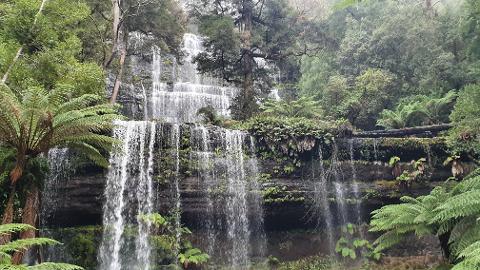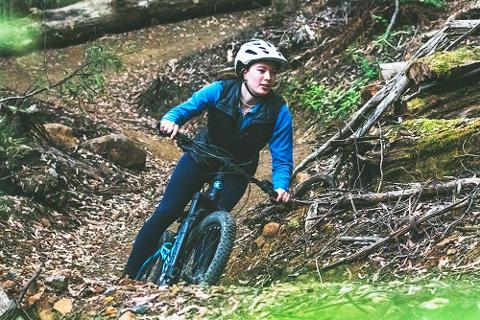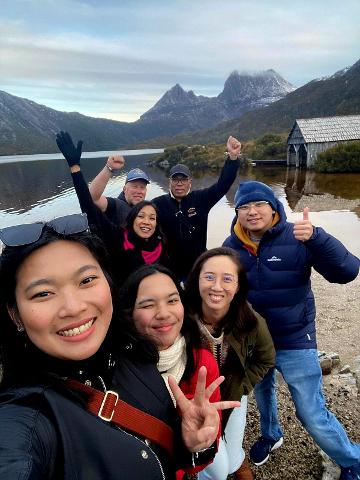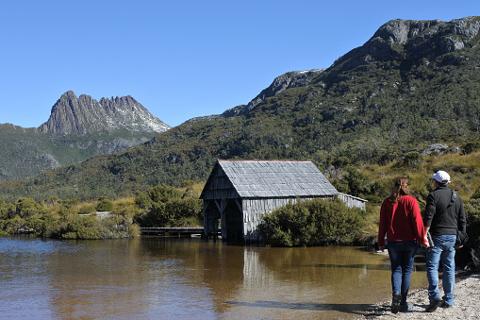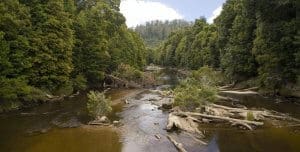








Cradle Mountain
Stunning scenery, crisp clean air and crystal clear lakes
WHAT SPARKS YOUR INTEREST?
Calm and serene, pleasant and rocky, it would be easy to assume that “Cradle Mountain” takes its name from a baby’s bed. But locals say no - it’s derived from the mountain’s resemblance to a miner’s cradle. This unique shape creates a dramatic vista that’s impossible to miss as visitors walk along the shores of the many lakes, river gorges and waterfalls that decorate the surrounding areas.
 The mountain itself is part of the Cradle Mountain-Lake St. Clair National Park in Tasmania’s Central Highlands -- one of 5 parks that form a UNESCO World Heritage Site known as the Tasmanian Wilderness World Heritage Area, spanning over 1 million hectares. Once upon a time, the area was blanketed by glaciers and ice, and is now one of the world’s last remaining stretches of temperate rainforest. Even cooler? Exploration of the area’s limestone caves has led to evidence of human occupation in the area harking back 20,000 years. Crafted by Mother Earth from sub-volcanic rock, Cradle Mountain stands 1,545 meters above sea level.
The mountain itself is part of the Cradle Mountain-Lake St. Clair National Park in Tasmania’s Central Highlands -- one of 5 parks that form a UNESCO World Heritage Site known as the Tasmanian Wilderness World Heritage Area, spanning over 1 million hectares. Once upon a time, the area was blanketed by glaciers and ice, and is now one of the world’s last remaining stretches of temperate rainforest. Even cooler? Exploration of the area’s limestone caves has led to evidence of human occupation in the area harking back 20,000 years. Crafted by Mother Earth from sub-volcanic rock, Cradle Mountain stands 1,545 meters above sea level.
How to Get There
By car, Cradle Mountain is about 2.5 hours from Launceston, 1.5 hours from Burnie, 1 hour and 15 min. from Devonport, and 4.5 hours from Hobart.
Activities and What to Do and See
 Though not Tasmania’s tallest mountain (rather, it ranks fifth), it’s one of the state’s most-visited tourist locales. Indeed, sightseers flock to the area year-round to undertake multiple-day treks that wind their way through the mountain’s peaks and valleys. The popular 6-day Overland Trek that leads adventurers through ever-changing scenes of natural beauty that starts in Cradle Valley and contorts around waterfalls and grassy plains, through thick jungles and across rushing rivers, to finish at Lake St. Clair, the country’s deepest natural lake. Though not without some challenges, the trek is gentle enough for all ages to enjoy, and tours with highly skilled guides run frequently.
Though not Tasmania’s tallest mountain (rather, it ranks fifth), it’s one of the state’s most-visited tourist locales. Indeed, sightseers flock to the area year-round to undertake multiple-day treks that wind their way through the mountain’s peaks and valleys. The popular 6-day Overland Trek that leads adventurers through ever-changing scenes of natural beauty that starts in Cradle Valley and contorts around waterfalls and grassy plains, through thick jungles and across rushing rivers, to finish at Lake St. Clair, the country’s deepest natural lake. Though not without some challenges, the trek is gentle enough for all ages to enjoy, and tours with highly skilled guides run frequently.
 In addition to the wide range of walk and trek tours available, Cradle Mountain can be enjoyed in a number of different ways. Horseback riding, canyoning (summer only), quad biking, canoeing (summer only), fly fishing (seasonal), mountain biking, boating tours on Lake St. Clair, or wildlife tours could be an exciting adventure for the entire family. Or even consider flying over the area in a helicopter to get a bird’s eye view of this stunning landscape!
In addition to the wide range of walk and trek tours available, Cradle Mountain can be enjoyed in a number of different ways. Horseback riding, canyoning (summer only), quad biking, canoeing (summer only), fly fishing (seasonal), mountain biking, boating tours on Lake St. Clair, or wildlife tours could be an exciting adventure for the entire family. Or even consider flying over the area in a helicopter to get a bird’s eye view of this stunning landscape!
Alternatively, if you’re looking to relax and unwind you might consider a wine and cheese tasting at a local lodge or immersing yourself in a spa and letting go of stress of the “real world”.
Where to Eat
There are a few popular places to choose from in the area, from a bistro to a high-end restaurant. Some tourists choose to bring groceries with them they picked up in Launceston, Deloraine or Sheffield. Each of these nearby towns has a good supermarket and this will ensure that you have plenty of food on hand for longer stays.
Accommodation
 For your ultimate wilderness getaway, you can opt to go rustic or choose a high-end luxury experience. Outdoor enthusiasts may appreciate the cabins, cottages, and self contained accommodations available in the great outdoors.
For your ultimate wilderness getaway, you can opt to go rustic or choose a high-end luxury experience. Outdoor enthusiasts may appreciate the cabins, cottages, and self contained accommodations available in the great outdoors.
Flora and Fauna
Among the many attractions to Cradle Mountain is its flora and fauna, the most talked about of which is the wombat. These short-legged marsupials, which resemble a big gerbil with a koala face, are easy to spot in the area, particularly in the colder months, when they can be easily caught grazing during the short daylight hours (about an hour before sunset seems to be their preferred time of day) due to the area’s extreme weather conditions.
 It’s also possible to spot Pademelons (imagine a cross between a bunny and a kangaroo), Tasmanian Devils, platypus and Echidnas (spiny anteaters). Bird watchers will delight in the area’s multitude of winged creatures that glide across the sky, from the Green Rosellas, Black Currawongs, Pink Robins, Yellow-tailed Black Cockatoo and Wedge-tailed Eagles who make their nests on the mountain’s cliffs, among many other kinds of birds. Highly venomous tiger snakes are also known to slink their way around their mountain, making the need for a tour guide quite apparent.
It’s also possible to spot Pademelons (imagine a cross between a bunny and a kangaroo), Tasmanian Devils, platypus and Echidnas (spiny anteaters). Bird watchers will delight in the area’s multitude of winged creatures that glide across the sky, from the Green Rosellas, Black Currawongs, Pink Robins, Yellow-tailed Black Cockatoo and Wedge-tailed Eagles who make their nests on the mountain’s cliffs, among many other kinds of birds. Highly venomous tiger snakes are also known to slink their way around their mountain, making the need for a tour guide quite apparent.
A wide diversity of fungi makes up a vital element of the park’s biodiversity. And though mushrooms may not be as exciting as wombats, most of the park’s plants have some sort of mutually beneficial relationship with fungi, which also function as its primary recyclers of organic matter.
Image Credits:
1: Sean Scott Photography
2: Paul Fleming
3,6,7,12,13: Tourism Tasmania
4,5: Great Walks of Australia
6: Kelly Slater
7: Lap Fung Lam
8,9: Jack Mohr Photography
3,12: Rob Burnett
11: Tourism Australia and Graham Freeman
13: Masaaki Aihara

